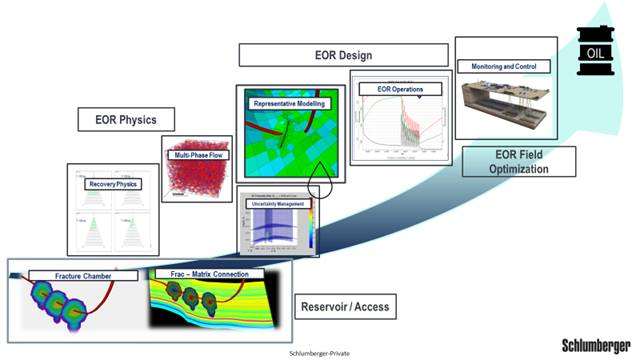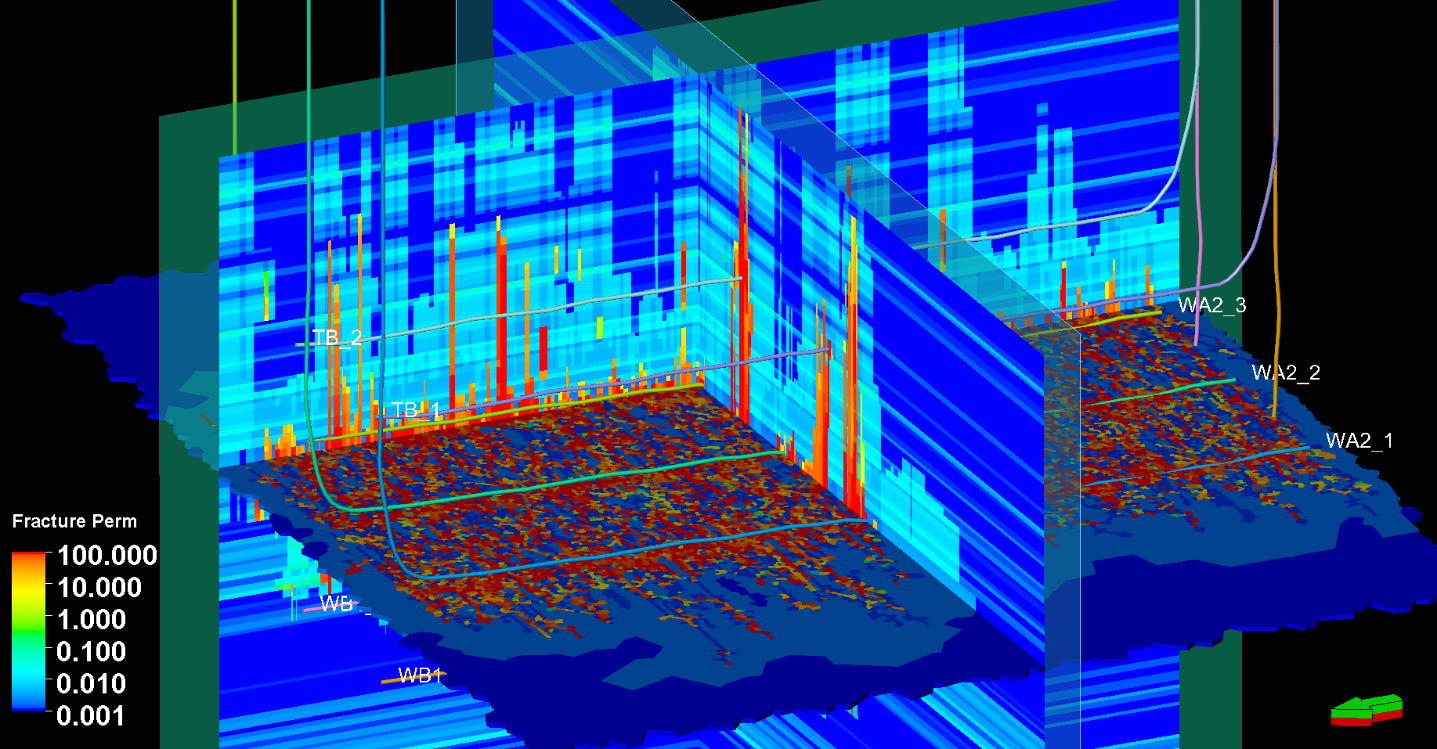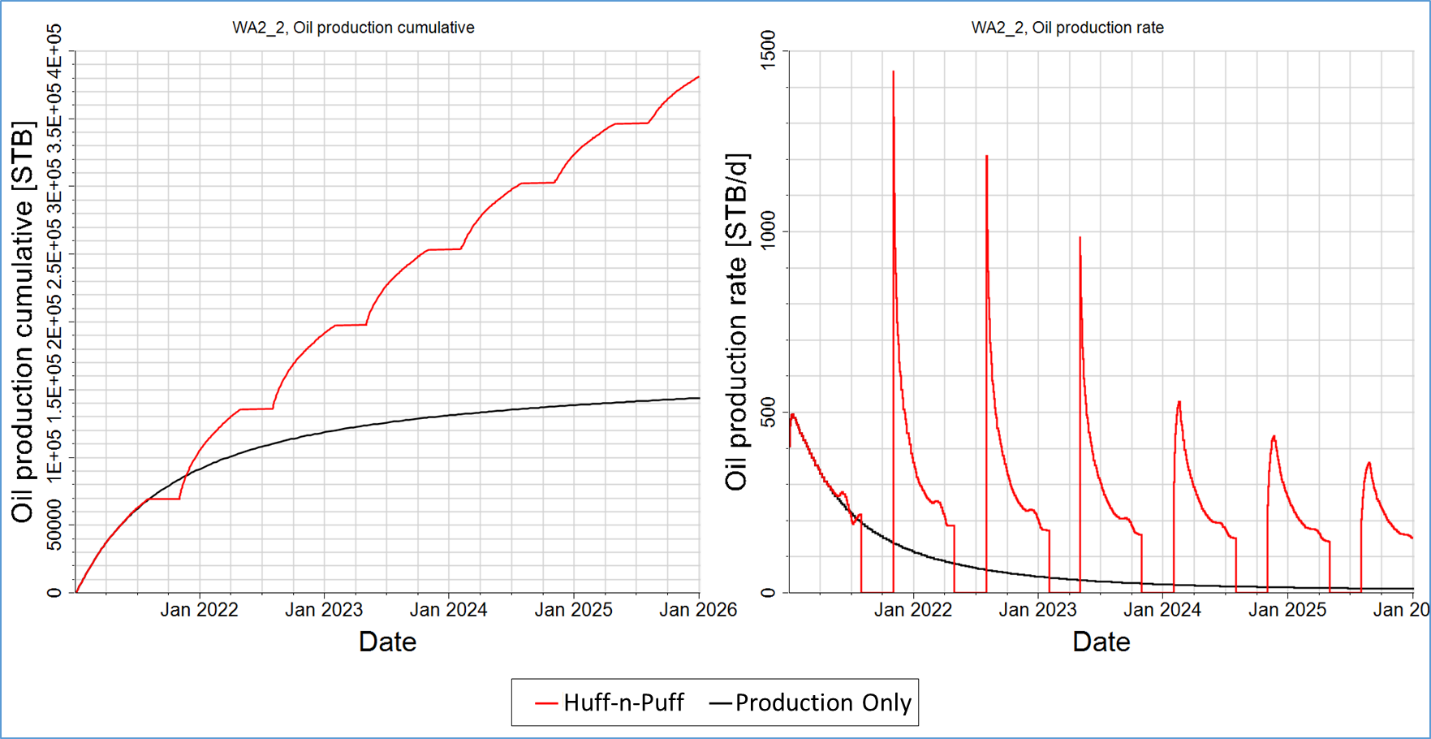The Power of CO2—Enhanced Oil Recovery for Unconventional Reservoirs
Shale oil is a key contributor today to oil production in the US. According to the Energy Information Administration (EIA) about 65% of US oil production is from tight oil resources. The powerful combination of horizontal drilling and hydraulic fracturing enables the US to significantly increase its production from those resources. However, because of ultra-low permeability and rapid depletion of pore pressure near the hydraulic fractures and wellbore, oil production for most wells declines sharply. It is estimated that the hydrocarbon recovery from these wells is going to be low, typically less than 10%.
Simply by drilling more wells by increasing the lateral lengths and number of hydraulic fracture stages to recover significant amounts of the remaining oil is not feasible. Therefore, there has been considerable interest in the application of enhanced oil recovery (EOR) methods. Among the EOR methods, injecting gases, primarily CO2, N2, and enriched natural gases can be applied in shale oil reservoirs. Injecting CO2 as an EOR method is becoming the most promising technique to extract tight oil resources as CO2 is more miscible compared with other gases.
CO2-EOR method
Oil recovery using CO2 in unconventional formations is different from recovery in conventional reservoirs. In tight formations, the injected CO2 first permeates the tiny pores and microfractures and consequently swells the oil and lowers its viscosity, thus mobilizing oil from the tight matrix to the conductive fracture network. This process can be repeated as ‘Huff-n-Puff’ in single well or multi-well scales. Such EOR applications can be converted to continuous CO2 injection in regional scales based on well pad communication.
Successful EOR projects primarily depend on how they are designed. Their design typically involves the integration of geology and geophysics, petrophysics, rock mechanics, completion, and stimulation design with the reservoir engineering concepts of hydrocarbon production, monitoring, and control. Figure 1 illustrates the integration of key parameters and activities used to optimize recovery in tight oil reservoirs.

Optimized software simulation
Kinetix reservoir-centric stimulation-to-production software is a plug-in available in the Petrel* E&P software platform. The plug-in enables seamless, comprehensive seismic-simulation workflows to optimize reservoirs with wells that require hydraulic fracturing. It supports multistage completion, stimulation design, and production evaluation for both conventional and unconventional reservoirs.
Kinetix software supports several hydraulic fracture modeling algorithms including the unconventional fracture model (UFM), which is particularly useful for unconventional formations. The UFM predicts the propagation of complex hydraulic fracture networks in a formation with pre-existing natural fractures. The UFM also models the interaction among hydraulic fracture branches by computing the stress shadow effect on each fracture exerted by the adjacent fractures.
The ability to accurately simulate the formation of fractures is fundamental to hydraulic fracture design, but reservoir simulation is also required for well pad or reservoir optimization. Production gridding and numerical simulation are the key components for evaluating well performance after completion and stimulation design. Kinetix software models hydraulic fractures explicitly. An automated gridding process creates a simulation grid on the network of fractures that integrates both matrix and hydraulic fracture properties. The results of the fracture simulator such as fracture geometry, conductivity, pressure, and saturation are transferred seamlessly to the dual porosity gridding system for numerical reservoir simulation. Numerical simulations are run with this grid using the INTERSECT* high- resolution reservoir simulator.
As the reservoir pressure declines with production, a depletion region is formed near the stimulated area. This causes a change in the magnitude and azimuth of the in-situ stresses. This phenomenon is modeled in Kinetix software by coupling the INTERSECT simulator with the VISAGE* finite-element geomechanics simulator. For optimal design of infill wells and refracture jobs it is important to consider this depletion effect.
Modeling miscibility
Since miscibility of gas in shale oil is the key to successful EOR in unconventional reservoirs, Schlumberger has paid significant attention to modeling miscibility. In the INTERSECT simulator, miscibility can be modeled using a variety of options in multiple simulation setups:
- In black-oil simulations, miscibility can be modeled using the implementation suggested by Todd and Longstaff[1]. It provides a four-component extension of the black oil model to enable simulating recovery mechanisms in which the injected fluids are miscible with the hydrocarbons in the reservoir. It enables gas injection projects to be modeled without the complexity and expense of using a full compositional model. The additional component/phase is the solvent phase, which is a part of the gas phase. To model the miscibility accurately, the absolute physical properties of the phase are modeled as effective properties, such as effective mass density, and effective viscosity. Similar to other effective properties, the effective relative permeability for the oil, gas, and solvent phases is calculated by interpolating between the immiscible and miscible values.
- In isothermal compositional simulations, miscibility may be modeled using one of the following two options:
- Using the Soave Redlich Kwong[2]-Peng Robinson[3] (SRK-PR EOS) Family: A compositional simulation with a cubic EOS can be used to model CO2 miscibility in oil.
- Isothermal Component Solubility in Water (CSIW): This option can model CO2 miscibility in the liquid phase as well as CO2 solubility in the aqueous phase, which is a major advantage of using this option for CO2 simulations.
- In thermal simulations, a user has the flexibility to model CO2 miscibility with or without modeling CO2 solubility in water. If CO2 solubility in water needs to be defined, a user may choose the thermal CSIW option.
There are some special considerations that a user may keep in mind while defining a CO2-EOR simulation. CO2 behaves quite uniquely in the super-critical region of the phase envelope, where its density resembles that of the liquid phase. However, viscosity resembles the vapor phase. So, the results of the EOS might need to be validated, especially in the EOR simulations. There are specially designed procedures for CO2 that can be used to validate/determine the CO2 phase-splits and fugacity.
Kinetix and INTERSECT case study
In the following example, a multi-well model has been constructed using Kinetix software to enable hydraulic fracture geometries of the multi-stage wells to be realistically preserved (Figure 2). The hydraulic fractures act as conduits for fluid to be produced from the low permeability formation that would otherwise be deemed uneconomical. The resulting INTERSECT reservoir model is a dual-porosity model to capture the behaviors of the two distinctly different flow media. Furthermore, it uses a compositional reservoir fluid model to accurately handle the physics of the miscible injection of CO2 or other injectant.
The swelling of the oil results in enhancing the flow from the matrix. Early results in the preliminary simulations with the Huff-n-Puff process show a 150% increase in oil recoveries is quite feasible provided that the switch to the unconventional EOR (UEOR) scheme occurs early in the production life of each well (Figure 3).


Conclusion
The effort to increase oil recovery from the giant unconventional basins of the US is expected to accelerate. Even a 5% additional recovery can result in significant gain for the unconventional resources industry. Seamless integration of Schlumberger technology encompassing the Petrel platform, Kinetix software, and INTERSECT simulator provides a powerful environment for designing the optimum EOR projects in unconventional assets.
Sources
1 Todd, M.R., and Longstaff, W.J.: “The Development, Testing, and Application of a Numerical Simulator for Predicting Miscible Flood Performance” Journal of Petroleum Technology (1972), 24, 7, 874–882.
https://doi.org/10.2118/3484-PA (accessed January 17,2022).
2 Soave, G.: “Equilibrium constants from a modified Redlich-Kwong equation of state” Chemical Engineering Science (1972), 26, 6, 1197–1203. https://doi.org/10.1016/0009-2509(72)80096-4 (accessed January 17, 2022).
3 Peng, D-Y., and Robinson, D.B.: “A New Two-Constant Equation of State,” Industrial & Engineering Chemistry Fundamentals (1976), 15, 1, 59–64. https://doi.org/10.1021/i160057a011 (accessed January 17, 2022).
Authors:
Omer Gurpinar, EOR Technical Director
Raj Banerjee, Advisor
James Wang, Reservoir Engineer
Raj Malpani, Stimulation Domain Manager
Scott Eberhardt, Business Development Manager
